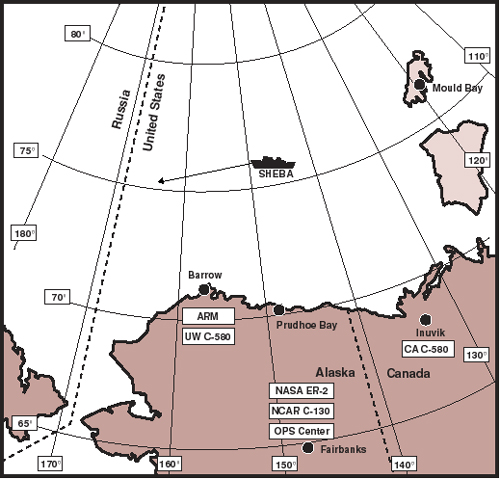FIRE-ACE: FIRE Arctic Cloud Experiment (FIRE-ACE)
FIRE, the First ISCCP (International Satellite Cloud Climatology Project) Regional Experiment, studied a variety of Arctic cloud systems under spring and summer conditions. A team of national and international scientists conducted the FIRE Arctic Cloud Experiment (ACE) in a two-phase field campaign, starting in April, 1998, and a second phase during July, 1998.
FIRE.ACE studied the impact of Arctic clouds on radiation exchange between surface, atmosphere, and space, and the influence of surface characteristics of sea ice, leads, and ice melt ponds on these clouds. An objective of FIRE.ACE was to document, understand, and predict the Arctic cloud-radiation feedbacks, including changes in cloud fraction and vertical distribution, water vapor cloud content, cloud particle concentration and size, and cloud phase as atmospheric temperature and chemical composition change. Scientists planned to use the data to focus on improving current climate model simulations of the Arctic climate, especially with respect to clouds and their effects on the surface energy budget. In addition, FIRE.ACE addressed a number of scientific questions dealing with radiation, cloud microphysics, and atmospheric chemistry.
The strategy of FIRE.ACE was to use aircraft to take remote and in situ measurements of the Arctic cloud and surface characteristics. The NASA ER-2 flew far aloft with a suite of remote sensors to remotely infer the cloud and radiative properties of the clouds that form in the vicinity of leads and melt ponds. The University of Washington Convair 580, National Center for Atmospheric Research C-130, and Canada National Research Council Convair 580 aircraft each flew with a number of in-situ instruments to measure the optical, physical, radiative, and chemical properties of the clouds and radiation directly.
NASA
Space Science and Engineering Center objectives in FIRE-ACE were to: 1) observe the infrared radiative characteristics of the Arctic; 2) retrieve cloud radiative properties; 3) retrieve atmospheric temperature and moisture profiles, and 4) support calibration of the MODIS Airborne Simulator.
Space Science and Engineering Center (SSEC), University of Wisconsin-Madison
Investigators
- Dr. Steven A. Ackerman Cooperative Institute for Meteorological Satellite Studies (CIMSS)
- Dr. Henry E. Revercomb Space Science and Engineering Center (SSEC)
Related Websites
Publications
-
Curry, J. A.; Hobbs, P. V.; King, M. D.; Randall, D. A.; Minnis, P.; Isaac, G. A.; Pinto, J. O.; Uttal, T.; Bucholtz, A.; Cripe, D. G.; Gerber, H.; Fairall, C. W. ; Garrett, J. T.; Hudson, J.; Intrieri, J. M.; Jakob, C.; Jensen, T.; Lawson, P. ; Marcotte, D.; Nguyen, L.; Pilewskie, P.; Rangno, A.; Rogers, D. C.; Strawbridge, K. B.; Valero, F. P. J.; Williams, A. G., and Wylie, D. FIRE Arctic Clouds Experiment. Bulletin of the American Meteorological Society v.81, no.1, 2000, pp5-29. Reprint #2649.
-
Maslanik, J. A.; Key, J.; Fowler, C. W.; Nguyen, T., and Wang, X. Spatial and temporal variability of satellite-derived cloud and surface characteristics during FIRE-ACE. Journal of Geophysical Research v.106, no.D14, 2001, pp15,233-15,249. Reprint #2941.
Images
-

Dr. Henry Revercomb and the HIS instrument
Space Science and Engineering Center (SSEC), University of Wisconsin-Madison -

HIS instrument
Space Science and Engineering Center (SSEC), University of Wisconsin-Madison -

Herbsleb and tape drive
Space Science and Engineering Center (SSEC), University of Wisconsin-Madison -

FIRE-ACE area of coverage
NASA
